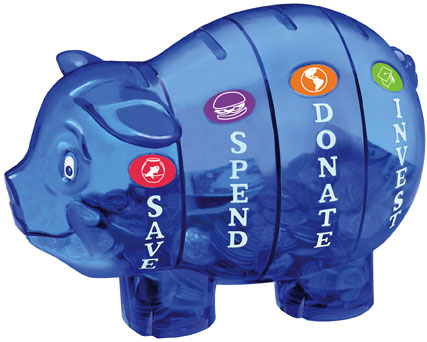Money Savvy Kids @Home™ is both a curriculum and an ongoing program designed to teach children about the nature of money as well as to how to manage it. You can begin to use it with children as young as about six years old, but you can also use it with children up to about age eleven. However, I think the course is probably best for children at least eight or nine years old. This course is not just about budgeting. It really serves as a very basic introduction to economics for children. With colorful illustrations, discussion, and practical applications, it teaches valuable concepts in regard to money that are generally neglected in most curricula.
Children learn that money doesn’t magically appear from ATM machines but that it has to first be put into the person’s bank account. They learn about the relative values of coins and bills. The course teaches about goods and services that people provide to earn money. Children begin to understand that when the money in an account is gone, you can’t take any more out until you put some back in. They learn about entrepreneurship and how to figure whether or not you can make a profit from a business idea. Children are encouraged to write out purchasing goals, to delay gratification, and to put money into a savings account so that they can earn interest. (Note: When it recommends savings accounts, it doesn’t mention the extremely low interest rates that we experience at present or the possibility of account maintenance charges imposed by some banks. It’s important when opening an account to investigate whether or not a bank has accounts without charges for young savers.)
The centerpiece of the program is the Money Savvy Pig®, a large, plastic piggy bank that is divided into four sections: save, spend, donate, and invest. You can choose a pink, blue, purple, or green pig, or you can substitute a cow or a football—all of them have the four sections. Children learn to put money they receive into the four sections of the pig. Lessons discuss why those four areas are important plus strategies for allocating money to each one. The “donate” lessons discuss giving to charities but do not address tithing or giving specifically to church. Parents can easily add that dimension in discussions about the family’s “favorite charities.”
The Money Savvy Kids @Home Kit comes with a packet that includes the "bank," a parent handbook, a student workbook, a coloring and activity book, a poster, and a presentation CD-ROM. The Money Savvy Pig bank includes a parent guide and goal-setting stickers as well.
You’ll start with the parent handbook to figure out how to use the various components, but the CD-ROM is your primary teaching tool. It includes 108, full-color lesson pages in PDF format that you can display on a computer or tablet. You read the brief text and discuss both the text and illustration on each page. The parent handbook has additional questions to ask—many of which will lead into discussions. For example, one page says, “Things you eat were also popular for trading. People traded corn, rice, salt...even bananas” (C1.6). The parent handbook presents two discussion questions: “If we still traded food today, what kind of food would you want to get?” and “What food would you want to trade away?” The parent handbook also has additional teaching information at the book that you might want to read through and use. The section on allowances and the Allowance Contract page might be especially helpful.
There are eight chapters in the course, and the concepts get increasingly complex. While the first chapter should be understandable for a six-year old, concepts introduced in the second chapter—bank account checks, deposits, and withdrawals—might be a bit more difficult to grasp. Later chapters have children think of a business they might start to earn money. Dog walking, lemonade stand, paper routes, babysitting or other simple ideas are suggested. (Note: Ideas like paper routes are probably no longer an option in many geographical areas.)
Since “invest” is one of the sections on the Money Savvy Pig, lessons also introduce the stock market and how it operates, encouraging children to buy a share of a company. As you can see, some concepts will be beyond many six-year olds, which is why I suggest an older age for starting the course.
The student workbook has two activity pages for each lesson with a few cut-outs to use at the back. These pages generally require a little written work, but nothing overwhelming. The coloring and activity book has mostly coloring pages, but there are a few pages for written activities and a word search puzzle. The CD-ROM that has the “text” pages also has four songs that you can play on a computer or CD player. The songs reinforce the concepts in the course, but they are purely supplemental, and I suspect most families will just skip them.
Money Savvy Kids @Home tackles some concepts sometimes reserved for older children. If your child has trouble with some of the lessons, you might pause at that point to just work on what children have learned thus far, then pick up where you left off when they are more mature. You might also look ahead to see how critical a particular concept is; maybe you can skip it for now and continue with other topics.
Money Savvy Kids @Home is an interesting approach for introducing some foundational ideas in economics at a level that children can understand, while it also serves as a very practical tool for teaching money management.













